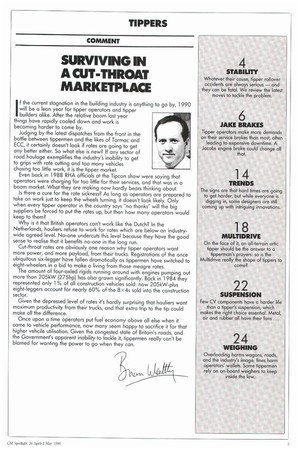SURVIVING IN A CUT-THROAT MARKETPLACE
Page 49

If you've noticed an error in this article please click here to report it so we can fix it.
If the current stagnation in the building industry is anything to go by, 1990 will be a lean year for tipper operators and tipper builders alike. After the relative boom last year things have rapidly cooled down and work is becoming harder to come by.
Judging by the latest dispatches from the front in the battle between tippermen and the likes of Tarmac and ECC, it certainly doesn't look if rates are going to get any better either. So what else is new? If any sector of road haulage exemplifies the industry's inability to get to grips with rate cutting and too many vehicles chasing too little work, it is the tipper market.
Even back in 1988 RHA officials at the Tipcon show were saying that operators were charging far too little for their services, and that was in a boom market. What they are making now hardly bears thinking about. Is there a cure for the rate sickness? As long as operators are prepared to take on work just to keep the wheels turning, it doesn't look likely. Only when every tipper operator in the country says "no thanks" will the big suppliers be forced to put the rates up, but then how many operators would keep to them?
Why is it that British operators can't work like the Dutch? In the Netherlands, hauliers refuse to work for rates which are below an industrywide agreed level. No-one undercuts this level because they have the good sense to realise that it benefits no-one in the long run.
Cut-throat rates are obviously one reason why tipper operators want more power, and more payload, from their trucks. Registrations of the once ubiquitous six-legger have fallen dramatically as tippermen have switched to eight-wheelers in a bid to make a living from those meagre rates. The amount of four-axled rigids running around with engines pumping out more than 205kW (275hp) has also grown significantly. Back in 1984 they represented only 1`)/0 of all construction vehicles sold: now 205kW-plus eight-leggers account for nearly 60% of the 8x4s sold into the construction sector.
Given the depressed level of rates it's hardly surprising that hauliers want maximum productivity from their trucks, and that extra trip to the tip could make all the difference.
Once upon a time operators put fuel economy above all else when it came to vehicle performance, now many seem happy to sacrifice it for that higher vehcile utilisation. Given the congested state of Britain's roads, and the Government's apparent inability to tackle it, tippermen really can't be blamed for wanting the power to go when they can.
























































































































